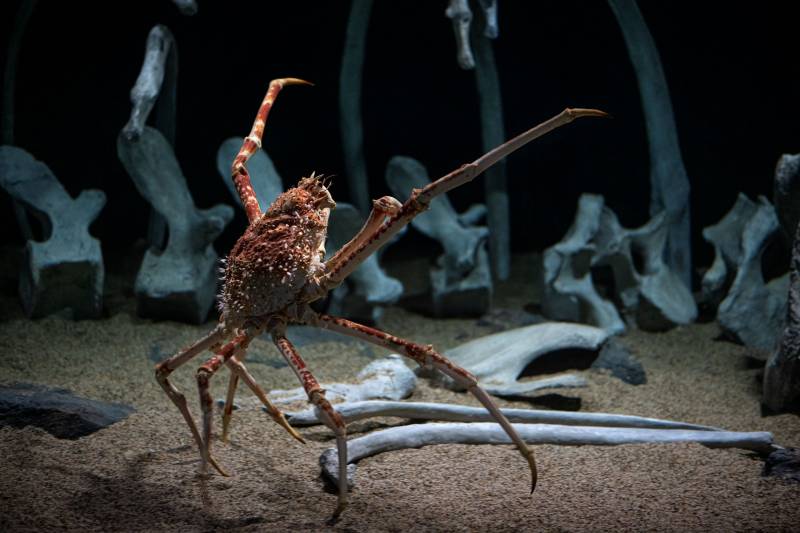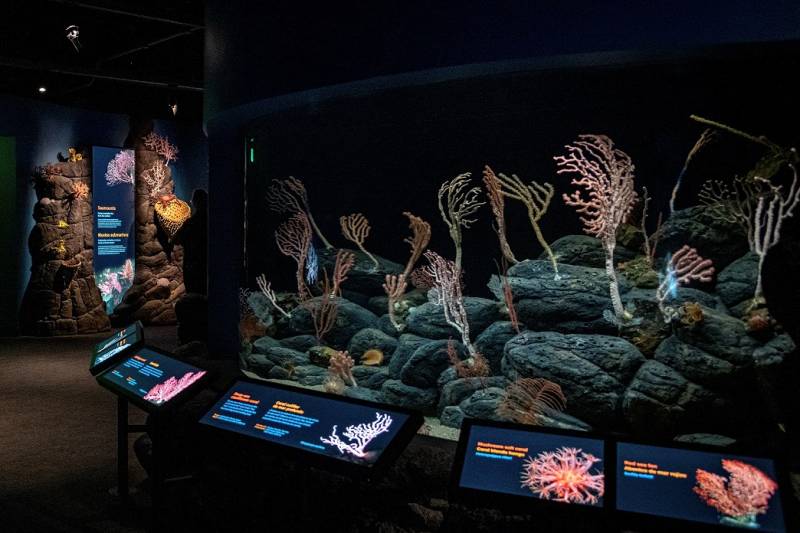The midnight zone is cold and dark, and can only be explored by remote operating vehicles (ROVs) controlled by pilots in submarines. The deep sea is rich with strange and often bioluminescent creatures, many of them delicate and unable to withstand the drastic transition to the low pressure, bright lights and high temperatures at the surface. Monterey Bay researchers have experimented for over a decade with ways to bring elusive deep-sea life safely up from the depths.
The exhibit takes visitors on a descending tour of the abyss, starting with a model of Monterey Bay’s underwater canyon. Some parts of the canyon are more than a mile deep, and the canyon comes remarkably close to shore. Visitors can meander through a darkened gallery of tanks displaying gelatinous creatures from the shallower end of the midnight zone, known as the midwater, which ranges from 650 feet to 3,300 feet deep.
 The Japanese spider crab is the size of a small dog. (Tyson V. Rininger/Monterey Bay Aquarium)
The Japanese spider crab is the size of a small dog. (Tyson V. Rininger/Monterey Bay Aquarium)
In the midwater gallery, screens show dazzling ROV footage of shimmering bioluminescence. A goopy string adorned with stingers — a creature known as a siphonophore — floats suspended in its tank.
Tommy Knowles, a jellyfish expert and one of the scientists who developed the exhibit, described his favorite midwater creature — a crimson dome bedazzled with ridges of strobing rainbow lights.
“This is the bloody belly comb jelly, Lampocteis,” Knowles said. “It’s one of the most delicate jellies in the world. It’s like a sparkly bowl of Jell-O.”
Knowles and other scientists tinkered with the acidity, light and temperature to achieve conditions that were just right for each deep-sea animal on display.
“We should be completely astounded by the technological things that they’ve done,” said Samantha Muka, aquarium historian and professor at the Stevens Institute of Technology in Hoboken, New Jersey. “It probably couldn’t have been done even 10 or 15 years ago. It’s that cutting-edge.”
While the deep sea is known for its high pressures, the aquarium scientists found that some deep-sea creatures could survive the ascent if they were given time to acclimate to the lower pressure and higher temperatures, not unlike the delicacy required when human divers return from high-pressure depths.
 Corals and sponges that grow on underwater mountains, or “seamounts” develop so slowly that damaged habitats could take centuries to recover. Drilling, mining, and fishing can put corals, sponges, and the animals they shelter at risk. (Tyson V. Rininger/Monterey Bay Aquarium)
Corals and sponges that grow on underwater mountains, or “seamounts” develop so slowly that damaged habitats could take centuries to recover. Drilling, mining, and fishing can put corals, sponges, and the animals they shelter at risk. (Tyson V. Rininger/Monterey Bay Aquarium)
“They’re the only people right now that know how you can push these animals, like the plasticity of their pressure needs at the moment,” said Muka. “They already know more about those deep-sea animals than we’ve ever known about them ever.”
While it took years of trial and error to figure out each deep-sea creature’s specific requirements, achieving low-enough oxygen levels proved to be a particular challenge. Many deep-sea creatures from an area known as the oxygen minimum zone need as little as 5% of the oxygen found at the ocean’s surface to survive. Some displays required developing new methods to strip oxygen out of seawater.
“We had to use equipment that I don’t think has ever been used in aquariums before,” Knowles said. “It was used in food production, for stripping gasses out of liquids.”
The exhibit is more than a technological marvel or a way to show off exotic animals. In addition to educating the public, it serves as a reconstructed ecological system that allows scientists to study deep-sea environments without the expense and difficulty of submarine voyages. This combination of public outreach and basic science is a hallmark of the Monterey Bay Aquarium.
“They’re basically setting up a long-term laboratory for those scientists to be able to study those organisms,” Muka said. “In some sense, it is the ultimate reason for the public aquarium to exist.”
Because it is so challenging to access and study, deep-sea biology is still in its infancy. Although scientists are only beginning to understand deep-sea environments, those environments are already under threat from human influence, such as deep-sea drilling, mining operations, climate change and microplastic pollution.
Deep-sea creatures feed on marine snow, tiny flecks of rotten flesh and other debris that drift down and eventually reach the sunless depths. But now, much of that snow is made up of tiny bits of microplastic.
To demonstrate how microplastic pollution affects deep-sea animals, the exhibit includes an interactive game that shows how hard it is for these animals to survive. Players take control of different deep-sea creatures and must avoid getting eaten or stung, all while chasing down and gobbling up bits of marine snow. If a player survives the game, the screen displays the percentage of plastic they consumed along with their marine snow meals — often more than half.
“As those plastics break down smaller and smaller, they get into the food chain,” said Protasio. “And these deep-sea critters may not be able to distinguish between what’s marine snow and what’s microplastic.”
At the deep end of the exhibit, visitors reach the muddy plains of the sea floor, studded with microhabitats. In one seafloor tank, spiny Japanese spider crabs the size of small dogs crawl over a model of a sperm whale skeleton settled into the mud. Cartilaginous ghost sharks lurk, and elephant fish probe for food with their long snouts.




















